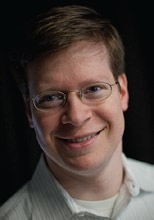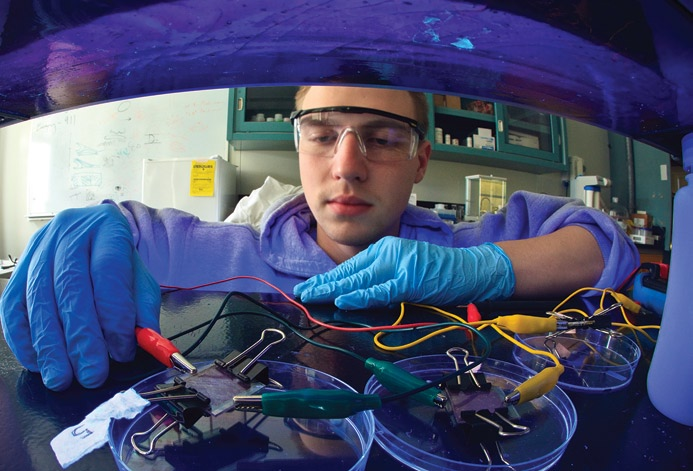In a YouTube video, two barefoot young men run across a pool of white liquid and the crowd cheers. When they try to stand on the liquid, they sink. The crowd roars.
The white liquid – particles of corn starch suspended in water – is a complex fluid whose flow properties, unlike those of water or honey, are not described by a single constant value of viscosity. You can bounce a spoon off the surface of a bowl of this mixture, or allow the spoon to sink slowly, because the fluid sometimes behaves like a solid.
Flowing suspensions and their internal structures make James Gilchrist excited to come to work. Beyond tricks, he sees applications that could improve many areas of life.
“Some scientists wake up in the morning to try to cure cancer,” says Gilchrist, the P.C. Rossin Assistant Professor of chemical engineering. “I want to learn more about how particles interact in fluids.”
In Lehigh’s Laboratory for Particle Mixing and Self-Organization, Gilchrist and his colleagues have learned to measure the internal structure of flowing suspensions and to resolve nanoscale deviations in these suspensions by tracking the relative positions of micronsized particles.
Predicting and controlling these deviations has enormous potential in a myriad of processes that involve suspensions. In mining, it could enable more efficient processing of waste sludge; in pharmaceuticals, it could reduce drug production costs. In medicine, it could lead to simpler analyses of blood to detect HIV and cancer. Suspensions are also widely used in coatings. Gilchrist is working with one colleague on a coating that would improve the efficiency of solar cells.
“Particles in suspensions are usually positioned randomly when at rest,” says Gilchrist. “When suspensions flow, as blood does, they are no longer homogeneous and this results in fluids having strange properties when the concentration of solids is relatively high.”
In their experiments, Gilchrist and his students control suspensions as they transition from fluid to gel. Using confocal scanning microscopy, they observe the 3-D structure of nanoparticles. As they increase the nanoparticle concentration, the fluid turns to gel. When they electrostatically charge the suspension, it reverts to fluid.
“Other researchers have theorized as to what’s happening, but we are the first to do experiments that directly measure how particles in fluids interact to generate these unusual forces,” he says. “We want to learn more about the kinds of microstructures that give complex fluids like blood or waste products macroscopic properties.”
Gilchrist’s group analyzes suspensions flowing in microchannels that are roughly the size of a human hair. When the suspension is not flowing, they observe particles randomly dispersed everywhere.
When the fluid is pushed through the channel, they watch the particles demix and migrate toward the channel center. This migration is a result of particles organizing themselves into clusters that dissipate stress in a nonuniform way. No one has measured the structures of these clusters until now. Gilchrist and his students, Changbao Gao and Bu Xu, can stop the flow, locate the position of every particle and determine their relationship to other particles.
Such information has the potential to improve blood analysis in HIV and cancer patients by controlling the blood flow so that sensors identifying AIDS and cancer cells actually come in contact with infected cells.
Gilchrist also collaborates with Prof. Nelson Tansu in the department of electrical and computer engineering on a DOE project to improve the lighting efficiency of light-emitting diodes (LEDs). Tansu creates high-efficiency LEDs; Gilchrist coats their surface with self-assembled microlens arrays to help extract light. Particles dispersed in a suspension organize when drawn into a thin film atop the LED. The resulting structure can enhance an LED’s overall performance by over 200 percent.
Gilchrist plans to continue studying the behavior of particulate systems.
“These systems behave in unpredictable ways. We want to develop an overarching theory that describes a broad range of suspension and granular flows. It’s as much art as science, which is part of what makes it fun to explore.”


